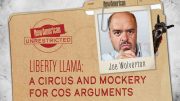
Richard Stengel is the author of the piece and his opening paragraph presents the thesis that he carries on throughout the rest of the story: "Here are a few things the framers did not know about: World War II. DNA. Sexting. Airplanes. The atom. Television. Medicare. Collateralized debt obligations. The germ theory of disease. Miniskirts. The internal combustion engine. Computers. Antibiotics. Lady Gaga."
The point, one made incessantly by those interested in unfastening the republic from its constitutional moorings, is that while the Constitution is an admirable document, it is dated and has served its purpose. Advocates of this position do not see how a document written over 200 years ago can adequately govern a modern country. Or, as Stengel restates his point in the third sentence of the very next paragraph: “Since George Washington didn’t even dream that man could fly, much less use a global-positioning satellite to aim a missile, it’s hard to say what he would think.”
What Stengel and those of similar mind fail to appreciate is that the principles of government laid out in the Constitution were already “outdated” in 1787. For example, the Constitution’s core concepts of separation of powers and federalism were already well-established features of republican governments in Greece and Rome.
In light of this fact, why did the generation of men who lived at the time of the framing of the Constitution (including those who disagreed with its ratification) not disparage those ancient concepts as being “out of touch” with the needs of an 18th-century population, separated from the people of ancient Rome and Greece by over a millennium?
They didn’t make that point because, unlike Time magazine, they understood that those principles of political philosophy were timeless and the statesmen of antiquity advocating those principles were men of sound understanding and not given to being tossed about by the ever shifting winds of popular opinion. To build the Constitution of the United States upon a foundation as solid and reliable as those that supported the exemplary republics of Rome and Greece was an act of unquestioned good sense, regardless of how old those principles were.
Finally, the article makes the point that regardless of how noble some of the freedoms protected by the Constitution may be (speech, assembly, and religion), Americans must remember, lest they put too much faith in the Constitution, that it was written by men who “were not gods and were not infallible.” In fact, these men were so far from divine that they owned slaves, denied women the right to vote, and agreed to the “crazy” idea that “South Dakota should have the same number of Senators as California.” So, before you join with the Tea Party and its “almost fanatical focus on the founding document,” you should recognize the depravity of the men who drafted it.
As evidence of the pliability and implausibility of the Constitution and the difficulty of applying any aspect of it to modern problems, Time highlights that challenge in the context of four current crises: Libya, ObamaCare, the debt ceiling, and immigration.
With regard to the use of American military resources in the Libyan civil war, Time magazine cites (with the frequent use of ellipses) two constitutional provisions related to the ability to wage war: Congress’ power to declare war in Article I, Section 8 and the President’s role as Commander-in-chief of the Army and Navy as set out in Article II, Section 2. From that moment, however, the article turns its attention to an analysis of the history and application of the War Powers Resolution.
The Constitution grants to Congress all legislative power. Laws passed by Congress and signed by the President then become “the supreme law of the land” (see Article VI). There is one qualification of that power, however. Article VI endows laws passed by Congress with legal supremacy provided that they are made “in pursuance” of the Constitution.
In the case of the War Powers Resolution, this piece of legislation grants the President more power than the Constitution by placing the use of the American armed forces at the President’s sole and unchecked discretion (albeit for 60 days before he must seek congressional approval for the continuation of the deployment). At best, this law is an end run around the Constitution, and at worst it is a disregard of the right of the legislative branch to declare war. Either way, it does not seem to pass the mandate of Article VI that to be valid, congressional acts must be made “in pursuance” of constitutional enumerations of power and not, as is the case with the War Powers Resolution, in violation of those designations.
Next, the Time article examines the question of how to apply the Constitution to the debate over raising the so-called debt ceiling. Again, citing ostensibly applicable constitutional sections, the article then branches out into a more esoteric description of the implications for the country of defaulting on its debts.
It is in the last paragraph of this section where the author of the article demonstrates an ignorance of the very plain language of the Constitution and the aforementioned principle of separation of powers.
At the same time, there’s nothing unconstitutional about the public debt’s exceeding the size of the GDP. It’s not wise, and we might look like Greece, but it’s not unconstitutional. And there’s nothing unconstitutional about Congress’s trying to impose cuts in the federal budget to decrease the size of the debt or to bargain for cuts in order to vote to raise the ceiling. But if in the end Congress seems intent on allowing the U.S. to default on its debt, the President can assert that that is unconstitutional and take extraordinary measures to avoid it.
Such statements are without any constitutional merit whatsoever. No single clause of Article II, wherein the very limited powers of the executive are defined, can be found to support the scenario portrayed (and promoted) by the author of the Time article. Unfortunately, many who read that piece will be awed by the reputation of the venerable news magazine and will not bother to recur to the actual text of our Constitution. Were they to do so, however, they would discover that the President is not constitutionally permitted to order an agency of the executive branch to “produce binding debt instruments that cover all of the U.S.’s obligations around the world. He can sell assets, furlough workers, freeze checks — heck, he could lease Yellowstone Park.” And no, sir, it would not “all be constitutional.”
ObamaCare is the third “crisis” listed in the Time article. According to the piece, “there’s nothing in the Constitution that restricts the government from asking us to do something or buy something or pay a tax — even if we don’t like it.” For proof of that assertion, the author references Congress’ power to “regulate commerce.”
Section 1, Article 8 of the Constitution grants Congress the authority to “regulate commerce with foreign nations, and among the several states.” The fact that Congress passed and President Obama signed the Patient Protection and Affordable Care Act into law demonstrates that neither the legislative nor executive branch of the national government is bothered by constitutional restrictions on their power. As a matter of fact, it is imprecise to say that the Constitution restricts the power of the national government. The truth is that the Constitution empowers the national government with very specific, limited and enumerated powers, leaving all others to the “states, respectively, or to the people.”
While the Constitution explicitly authorizes Congress to regulate commerce and the Supreme Court has validated the exercise thereof in a string of decisions, there is no precedent in our over 200 years of constitutional jurisprudence for the ability of Congress to force citizens to buy something regardless of their own preference. This latest expression of the legislative madness denigrates the very principle of personal liberty that is at the core of our constitutional Republic. If Congress is permitted to envelop the iron fist of absolutism within the velvet glove of the Commerce Clause, then there is nothing that will not fall within that purview.
Finally, the article illustrates the Constitution’s supposed flexibility by applying its provisions to the immigration debate, specifically the “anchor baby” issue.
The anchor in “anchor babies” refers to the purported ability of children born in the United States to illegal immigrant parents to sponsor those parents in their request for permanent residency here. According to the argument, as citizens of the United States, those children have the right to sponsor the immigration efforts of family members seeking legal immigration status. The lawful ability of American citizens to serve as sponsors to would-be immigrants is not in question. What is in question, however, is whether children born within the sovereign borders of the United States should be endowed with the full panoply of privileges and immunities of which citizens are possessed. This is the crux of the current controversy.
Any reading of the plain language of the 14th Amendment coupled with the pertinent legislative commentary reveals that a child born to persons illegally present in the United States cannot be thought to benefit from the boon of citizenship when their parents are by very definition aliens to the “extent and quality” of that most desirable status. Can the fountain of liberty send forth the sweet water of citizenship at the same place as the bitter water of unlawful entry?
The most important consideration is whether, at the time of his birth, either of a person’s parents owe allegiance to a foreign power. If the answer to that question is yes, then it doesn’t matter if that person was born in the torch of the Statue of Liberty on the Fourth of July, he cannot be a citizen of the United States as his parents, those from whom he derives his civic rights, were bereft of that blessing and thus unable to pass such onto their children.
Although the author of the Time magazine article in question opens by informing readers that “it’s difficult to know what he [James Madison] would say” about this or that contemporary issue, he concludes the article by telling us exactly “what the framers would say.” This contradiction is consistent with the rest of the article. While opening with an explanation of how a people so distant in time and technology could not be relied upon to solve modern problems, the author then asserts that those problems actually could be solved constitutionally if only we understood that document better.
Readers of Time and The New American would be best served by recurring to the text of the Constitution and not relying on the self-interested interpretation thereof by any commentator.




